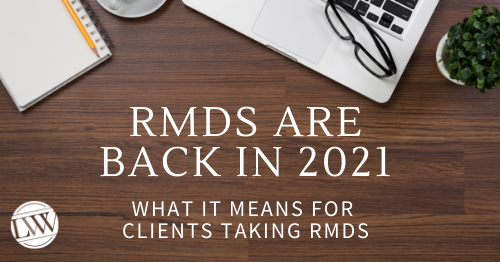By Jonathan Thomas, CFP, Private Wealth Advisor
As part of the Coronavirus Aid, Relief and Economic Security Act (CARES Act) of 2020, retirees were able to forgo taking Required Minimum Distributions (RMDs) from IRAs or other defined contribution plans, such as 401(k) plans. Many converted a portion of their unwanted RMD into a Roth IRA, a tax-free asset to spend in retirement or to leave to the next generation. We even deemed 2020 “The Year of The Roth IRA.”
The most recent COVID relief bill did not extend this waiver into 2021. You may be wondering if there is a possibility that RMDs will also be waived for 2021 sometime later in the year. It is unlikely that this administration will consider eliminating the RMD as “relief,” as one could argue it unfairly benefits the wealthy or those less affected by COVID-19. Assuming RMDs are again required, how should we plan?
If you need the money, set up a recurring schedule of distributions. Taking this action upfront will avoid delaying your RMD until the end of the year, perhaps having to sell during a correction. Recall the “Christmas Eve Massacre” of 2018? Waiting until the end of the year likely would have cost you, as the Dow was off 19% from its high just two months prior. You may be able to avoid this by setting up your distributions to occur throughout the year.
Roth conversions remain an option but are now more complicated. The first dollars out of an IRA are classified as your RMD. For example, if you want to make a $20,000 Roth conversion and your RMD is $50,000, you must distribute $50,000 before converting the $20,000 to a Roth IRA, making your total (taxable) distribution $70,000.
Consider “Bracket Bumping.” This strategy involves managing your taxable income to “fill up” your tax bracket, without “bumping up” into the next marginal tax rate. For example, if your joint taxable income is $150,000 in 2021, you might consider taking an additional distribution from your IRA to maximize the 22% marginal tax bracket ($172,750 being the maximum). You may want to roll the extra distribution into your Roth IRA as a partial Roth conversion. A strong reason to consider taking this action is if you think tax rates are likely to be higher in the future.
Think charitably. Qualified Charitable Distributions (QCDs) are direct, tax-free payments from your IRA to qualified charities. One feature of QCDs is that they DO count toward your RMD for the year! For example, if your RMD is $20,000, you might do a $5,000 QCD (or multiple distributions totaling $5,000), leaving just $15,000 remaining as your RMD for the year. You must be over age 70.5 (and yes, this is different than the starting age of RMDs).
Leave part of your IRA to charity. In your will, you may direct a percentage of your estate to a charitable cause you care about. Why not name the charity as an owner (or partial owner) of your IRA? It may be better to leave your taxable investment assets or property to family members, as those assets get a step-up in basis of the market value at date of death, as IRAs are fully taxable upon distribution.
Don’t forget about inherited IRAs! If you are the beneficiary of a Traditional or Roth IRA, you will resume taking an RMD in 2021. Keep in mind, if you inherited an IRA January 1, 2020 or later, you must deplete the entire IRA within 10 years (following the 10-year rule, which is new under The SECURE Act).
We will be closely watching what happens in Congress to see if the next COVID-19 relief bill waives RMDs for 2021, similar to how they were suspended in 2020. If you take a distribution and RMDs are ultimately waived, you will likely be able to return the unwanted RMD like last year. As we saw in 2020, events can unfold rapidly, and tax laws can change very quickly in response. We should expect the unexpected, but have a plan for what we know today.
The information contained in this summary is for informational purposes only and any opinions expressed are current only as of the time made and are subject to change without notice. The information provided is not intended to be, and should not be construed as, investment, legal or tax advice. Any investment advice provided by LVW Advisors is client specific based on each clients’ risk tolerance and investment objectives. This commentary is not intended or written to be used, and cannot be used, by a taxpayer for the purpose of avoiding penalties that may be imposed by law. Each taxpayer should seek independent advice from a tax professional based on his or her individual circumstances.









